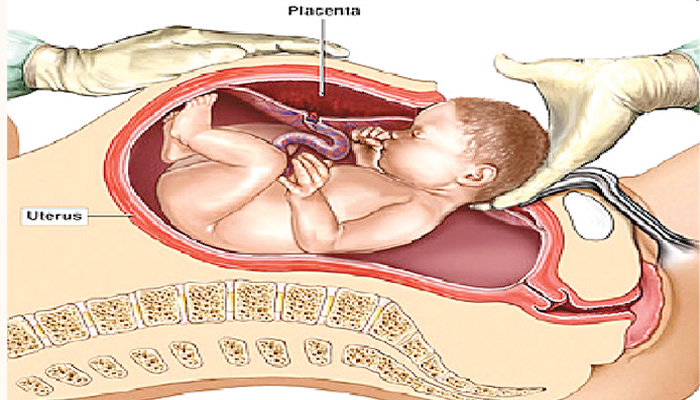Leading maternal health experts say women should forget the idea of trying for a vaginal delivery after undergoing two or more caesarean sections.
They warned that embarking on such a venture is dangerous and may lead to the death of both mother and child as a result of uterine rupture.
The gynaecologists noted their concern is for every pregnant woman to deliver safely and for the baby to be in good condition irrespective of the birth process.
Speaking exclusively with PUNCH Healthwise, the senior health professional urged pregnant women not to allow culture or preference for a particular gender to push them into making wrong decisions that could jeopardize their health and that of their babies.
The Vice-Chancellor of the Federal University of Medical Science, Otukpo, Benue State, told our correspondent that culture and custom still pose a lot of challenges to maternal health in many communities in Nigeria, and called on the government to intensify awareness against such.
The former President of the Nigerian Medical Association, who is a Professor of Obstetrics and Gynaecology, however, said the number of pregnant women delivering their babies through CS is increasing in Nigeria and dismissed claims that deaths from the surgical procedure are on the rise.
According to new research by the World Health Organisation, CS use continues to rise globally and accounts for more than one in five (21 per cent) of all childbirths.
WHO noted that the number is set to rise over the coming decade, with nearly a third (29 per cent) of all births likely to take place by CS by 2030.
The gynaecologist, who gave an insight into the dangers of going for vaginal delivery after two cesarean sections said, “First, the woman may deliver without any problem. Second, the woman may deliver and rupture her uterus, bleed to death and the baby survives. The woman delivering through the vagina could get her uterus ruptured, leading to death. The baby could also die.
“So, it is a tragedy. We need to sensitize our people in churches, communities and meetings to go to the hospital. It does not matter how you deliver your baby. The most important thing is for you and your baby to be okay.”
According to him, CS is not a punishment but an acceptable option for vaginal delivery.
Prof. Ujah further explained, “And when we do that, we reduce death from ruptured uterus or from mismanaged cases in churches or prayer houses.
“Women should forget about vaginal delivery after two or more CS because what we are looking for is not the root of delivery, we are looking at the health of the mother and the baby.
“They shouldn’t try it because the uterus will give way. The place is weak and once you stitch a place, the place becomes weak.
“If you stress the uterus and labour is a very stressful thing, it will pull apart and the old scar will give way. And we don’t want to encourage that and the risk is too much, particularly when early medical intervention is not there.”
He further cautioned women against allowing culture and customs to compel them into having vaginal delivery that would endanger their lives.
According to him, “The unfortunate thing is that we have many contending factors. One of the problems is culture and customs. Among the women in the southeast, there is this feeling that if a woman does not have a vaginal delivery, she is not a woman.
“And that compels women to have babies by vaginal delivery. For us (gynaecologists) it doesn’t matter whether it is vaginal delivery or caesarean section.”
Continuing, he said, “What we are looking for is for a sound healthy baby and for the mother to be fine. This matter is not helped by prayer houses.
“When our women go to the clinic and the doctor says because they have had two or three CS, it is risky to have another one through the vagina and would need to have another CS. The desperate ones due to the influence of culture and customs, would go to prayer houses, and in some of these places, the pastors would tell them lies.”
The don urged pregnant women to go for antenatal care in hospitals, where they would be attended to by skilled birth attendants, and not to joke with their health. He also enjoined them to plan for their delivery.
On the maximum number of CS that a woman should undergo, the gynaecologist said, “The doctor will assess the integrity of the care. It is not the number of CS that is important but the care. And it is also important to know that we are not bothered about the gender of the baby whether male or female.”
Also speaking, another maternal health expert and Professor of Obstetrics and Gynaecology, Ahmadu Bello University, Zaria, Solomon Avidime, advised pregnant women with small pelvises to stop refusing to undergo caesarean section due to cultural and religious beliefs.
He said such refusal comes with many risks, warning that delivering a big baby through a small birth canal can cause serious complications, including the death of the baby.
Prof. Avidime explained that if a pregnant woman has a small pelvis, the possibility of vaginal delivery is limited, noting that such women are usually offered CS as an option to avoid complications.
The professor, however, said women with small pelvises could still give birth vaginally, depending on the size of their babies.
“Occasionally, we encounter women that will refuse CS when offered to them, as a way to aid safe delivery. They often refuse such an offer because of their cultural and religious beliefs.
“Some of them have ended up regrettably losing their babies because, by the time they eventually agree, the situation would have become worse. They usually have an outcome that is unwanted.
“Now, if a woman that is to deliver through CS refuses, obviously, she can’t deliver on her own, or even if she eventually does, she will have complications and the baby may die. Also, the mother can have injuries, bleed and may also die.”
He warned that babies forced out of a small birth canal could also have deformities later in life.
PUNCH




